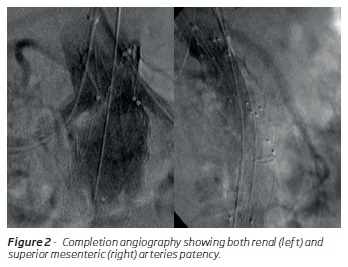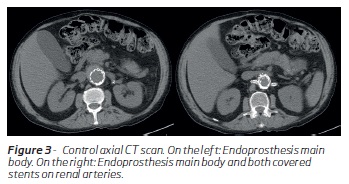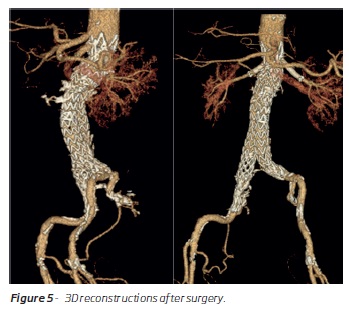Serviços Personalizados
Journal
Artigo
Indicadores
Links relacionados
Compartilhar
Angiologia e Cirurgia Vascular
versão impressa ISSN 1646-706X
Angiol Cir Vasc vol.15 no.4 Lisboa dez. 2019
CASOS CLÍNICOS
Chimney technique for treatment of a symptomatic abdominal aortic aneurysm in an urgent situation: a case report
Técnica chimney para tratamento de aneurisma da aorta abdominal sintomático em situação urgente: caso clínico
João Diogo Castro1, Pedro Sá Pinto1, João Gonçalves1, Vítor Ferreira1, Carlos Veterano1, Carlos Veiga1, Gabriela Teixeira1, Inês Antunes1, Daniel Mendes1, Henrique Rocha1, Maria Sameiro Caetano Pereira1, Rui Machado1, Rui Almeida1
1 Angiology and Vascular Surgery Department of Porto Hospital and University Center
Endereço para correspondência | Dirección para correspondencia | Correspondence
ABSTRACT
The number of patients treated with abdominal aortic aneurysm (AAA) increased considerably in the last decades. Even though open surgery remains the gold standard for AAA treatment, endovascular techniques like Chimney grafts (CGs) showed to be reliable to treat patients with contraindications for conventional surgery and hostile neck aneurysms. CGs are off-the-shelf stents which are accessible and useful for urgent/emergent cases.
This work reports a case of a 67 years-old caucasian male with a symptomatic infrarenal aortic aneurysm having a 2.5mm short neck and a maximum diameter of 67 mm. Due to patient comorbidities and after ruling out other causes for the pain, he was treated in urgency with chimney technique to prevent rupture.
Keywords: AAA, Juxtarenal Abdominal Aortic Aneurysm, Hostile neck, Chimney, CHEVAR, Parallel grafts
RESUMO
O número de doentes tratados a aneurismas da aorta abdominal (AAA) aumentou consideravelmente nas últimas décadas.
Apesar da cirurgia convencional permanecer o gold standard para o tratamento de AAA, técnicas endovasculares como a técnica de Chimney demonstraram ser seguras em doentes com contraindicação para cirurgia convencional e aneurismas com colo hostil.
A técnica de Chimney é realizada recorrendo a "off-the-shelf stents" que são acessíveis e úteis em casos urgentes/emergentes.
Reportamos o caso de um doente do sexo masculino de 67 anos, caucasiano, com um aneurisma da aorta infrarrenal sintomático. O aneurisma apresentava um colo curto de 2.5mm e um diâmetro máximo de 67 mm.
Devido às comorbilidades do doente e excluídas outras causas para a dor, foi decidido tratamento urgente do mesmo recorrendo à técnica de Chimney.
Palavras-chave: AAA; Aneurisma da aorta abdominal justarrenal; Colo hostil; Chimney; CHEVAR; Enxertos em paralelo
Introduction
The number of patients treated with abdominal aortic aneurysm (AAA) increased considerably in the last decades. Even though open surgery remains the gold standard for AAA treatment, endovascular techniques like Chimney (also known as CHEVAR, Parallel grafts or snorkel) showed to be reliable to treat patients with contraindication for conventional surgery and hostile neck aneurysms(1).
Non-fit patients with severe cardiopulmonary disease should not be submitted to open surgery when other techniques are available(1).
Chimney is very often compared with fenestrated grafts (FGs) but these are more expensive, need customization and several weeks to be available, so it is not yet an option to be considered in urgent/emergent situations. Contrarily to FGs, CHEVAR Chimney uses off-the-shelf stents overcoming those mentioned difficulties.
We report a case of a symptomatic infrarenal aortic aneurysm with a hostile short neck treated with Chimney technique.
Case report
A 67-year-old Caucasian male was admited to the Pneumology department because of severe exacerbation of chronic obstructive pulmonary disease (COPD) symptoms due to a respiratory infection. The patient was on oxygen therapy at home. He started complaining of pain in the right inguinal region irradiating to the right hypochondrium that was not responsive to analgesics.
The patient had a known infrarenal aortic abdominal aneurysm with a maximum diameter of 60 mm and a right common iliac artery with a maximum diameter of 32 mm detected in a CT scan performed two years before.
Other concurrent medical conditions were: atrial fibrillation; congestive heart failure; ex-smoker; hypertension; dyslipidemia; type 2 diabetes; benign prostatic hyperplasia; colonic diverticular disease that needed extended sigmoidectomy; abdominal wall eventration and bilateral inguinal herniorrhaphy.
The most common causes for abdominal pain were discarded.
A new contrast enhanced CT scan was made and showed an infrarenal aortic aneurysm with a 2.5 mm neck, 19mm neck's diameter and 67 mm maximum diameter. The right common iliac artery aneurysm had 35 mm diameter. The aneurysm sac had a circunferencial non fissured intraluminal homogeneous thrombus and moderate calcificacion. The aneurysm neck did not have any significant thrombus or calcification. No lesions were detected in the thoracic aorta. (Figure 1)
The decision to use a Chimney technique, was based on the patient's severe comorbidities, short infrarenal aortic neck out of instructions for use for most of the available endografts and need of expeditious treatment precluding planning for other endovascular options.
The procedure consisted of a Chimney using a bifurcated aortic endoprosthesis (Endurant II, Medtronic (28×16×166mm)) and self expanding covered stents for the renal arteries (Viabahn, Gore 6×50mm).
Both humeral arteries were exposed under local anesthesia and the renal arteries catheterized with the stent graft delivery catheters. Under spinal anesthesia a cut down exposure of the right and left femoral arteries was made, and the aortic endoprosthesis main body was delivered via femoral access. A proximal aortic extension cuff 28mm long was required to increase sealing. Two iliac artery extensions were also deployed ipsilateral via right and left femoral access. The completion angiography showed an excluded aneurysm with no endoleaks and patency of both renal arteries and superior mesenteric artery. (Figure 2)
The abdominal pain ceased immediately after surgery and no complications were noted during immediate follow-up.
Before discharge, the patient had a control CT scan where no evidence of endoleaks were detected. (Figure 3,4 and 5)
Due to a new COPD exacerbation, the patient came to the Emergency Department and a new angio CT scan was deemed necessary to rule out Chimney's complications. This new CT scan, 1 month after surgery, showed an aneurysmatic sac with 67 mm and no endoleak instability or rupture signs.
Before and after all the imagiologic exams and surgery the patient renal function did not suffer any change and maintained with an estimated glomerular filtration rate of 116ml/min.
Discussion
Nowadays, open repair surgery is the gold standard treatment for AAA treatment(2) involving the visceral arteries. However, some patients are unfit for open surgery and endovascular treatment is an option(3).
Around 30 to 50% of patients with AAA are not fit for elective conventional endovascular repair due to anatomic constraints in the proximal neck(4).
From the total of AAA, around 15% are juxtarenal aortic aneurysms (degenerative aneurysms with extension to the level of renal arteries) and need careful planning to preserve abdominal aorta main branches'(4).
To preserve the branches' patency, parallel graft techniques have emerged, and Chimney technique is the most frequent parallel-graft procedure(5).
In fact, Chimney technique was first used as a bailout technique for accidental coverage of visceral arteries during EVAR(6).
The Chimney technique is based on the placement of a stent parallel to the aortic endograft and its main goal is to achieve an adequate proximal sealing zone and keep aortic branches patent through covered stent grafts(2, 7).
Among the indications to perform Chimney technique we can find high risk for open surgery due to anatomy, cardiovascular disease, chronic obstructive pulmonary disease and hostile abdomen(1). Our patient had all of the mentioned comorbidities and therefore the Chimney technique seemed a valid option.
Other option for non-fit patients is FEVAR (fenestrated EVAR) but it takes time, for precise planning and endoprosthesis customization, making it unsuitable for urgent/emergent situations (2,1).
In contrast, Chimney technique is an effective therapy with high initial technical success rate, fair perioperative outcomes, less complex to perform, widely available and feasible in the acute setting(2).
So, considering the mentioned reasons, Chimney technique seemed to be the most suitable procedure for our patient.
Nevertheless, Chimeny has its own downfalls. The main concern is endoleak type Ia(1-3).
Yue Li et al reported an occurrence of endoleaks type IA in 7.6% of the cases. Other complications such as renal function impairment (11%), artery thrombosis (3.4%), strokes (2.7%), cardiac events (2.1%), intestinal ischemia (1.7%) and access complications (5.1%) were also reported.
At the last visit to our outpatient clinic corresponding to a 8-month follow-up, none of the above complications had occurred.
Conclusion
Chimney technique is a useful and practical solution for symptomatic AAA with short neck in patients unfit for open surgery.
It can be done in most centers with experience in endovascular aneurysm repair.
Endoleaks and occlusion of abdominal aortic branches are important complications that must be closely monitored.
REFERENCES
1. Igari K, Kudo T, Toyofuku T, Inoue Y. The outcomes of endovascular aneurysm repair with the chimney technique for juxtarenal aortic aneurysms. Ann Thorac Cardiovasc Surg. 2016;22(3):174-80. [ Links ]
2. Li Y, Zhang T, Guo W, Duan C, Wei R, Ge Y, et al. Endovascular chimney technique for juxtarenal abdominal aortic aneurysm: a systematic review using pooled analysis and meta-analysis. Ann Vasc Surg [Internet]. 2015;29(6):1141-50. Available from:http://www.ncbi.nlm.nih.gov/pubmed/26004962. [ Links ]
3. Jabr A Bin, Lindblad B, Kristmundsson T, Dias N, Resch T, Malina M. Outcome of visceral chimney grafts after urgent endovascular repair of complex aortic lesions. J Vasc Surg [Internet]. 2016;63(3):625-33. Available from: http://dx.doi.org/10.1016/j.jvs.2015.09.023. [ Links ]
4. Li Y, Hu Z, Bai C, Liu J, Zhang T, Ge Y, et al. Fenestrated and Chimney Technique for Juxtarenal Aortic Aneurysm: A Systematic Review and Pooled Data Analysis. Sci Rep [Internet]. 2016;6(January):1-12. Available from: http://dx.doi.org/10.1038/srep20497. [ Links ]
5. Criado FJ, Donas KP. Overview of Chimney Endovascular Technique [Internet]. Vol. 12, Endovascular Treatment of Aortic Aneurysms. Elsevier Inc.; 2018. 27-29 p. Available from: https://linkinghub.elsevier.com/retrieve/pii/B9780323511483000066. [ Links ]
6. Rouer M., El Batti S., Julia P., De Blic R., Fabiani J.-N., Alsac J.-M.Chimney stent graft for endovascular sealing of a pararenal aortic aneurysm (2014) Annals of Vascular Surgery, 28 (8) , pp. 1936.e15-1936.e18.
7. Calero A, Illig KA. Overview of aortic aneurysm management in the endovascular era. Semin Vasc Surg [Internet]. 2016;29(1-2):3-17. Available from: http://dx.doi.org/10.1053/j.semvascsurg.2016.07.003. [ Links ]
Endereço para correspondência | Dirección para correspondencia | Correspondence
Correio eletrónico: joãodiogocastro@outlook.com (J. Castro).
Disclosure
The authors of this article do not have any potential conflict of interest.
Recebido a 15 de junho de 2019
Aceite a 03 de dezembro de 2019



















